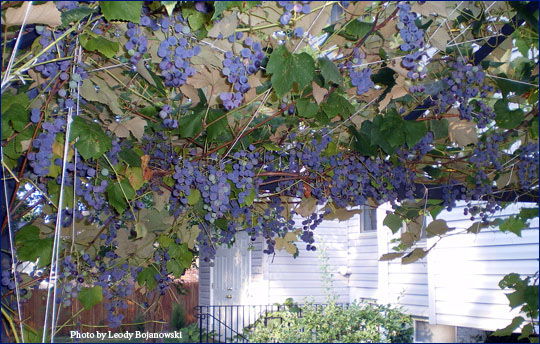Plants
All plant vegetative and reproductive growth occurs in cells. Chlorophyll molecules in a cell transform solar energy into chemical energy and gives leaves their green color.

Transpiration occurs when plant tissues draw water and minerals up from the ground. Xylem in the stem transports water and minerals throughout the plant. Rapid plant growth occurs in spring, slower growth in the fall and no growth in winter. Phloem carries carbohydrates and other foods manufactured in the upper portions of a plant. Sufficient water in a plant’s cells allows stems to stand erect while deficient water supply causes them to droop.
Branch or stem formation on a woody plant takes place at a bud. The node is a portion of a stem where buds are located and where leaf petioles are attached. Bud placement along a stem forms in opposite, alternate or whorled patterns. A bud can produce only leaves and stems (vegetative), only flowers or both.
The root absorbs water from the soil and minerals from the soil. Root modifications (below) act as pantries for future food intake. Root hairs are delicate and when planted without protection of moist soil, are vulnerable to burn from excess fertilizer and suffocation from compacted soil, which lacks oxygen and proper drainage. Too much nitrogen fertilizer produces lush foliage while depleting flower production. A plant can have either a fibrous root or singular taproot to get a drink. The grass plant has many roots while a carrot or rosebush is tap-rooted. With fibrous roots, it is easier for a plant to hold a soil ball for moisture and minerals. Without water in the soil, a root can’t obtain minerals from the soil.
Excess fertilizer in the root zone will compete with sugar, diluting the water content in the soil and preventing water from entering the plant’s roots.
 A plant’s leaf or herbaceous (non-woody) stem manufactures sugar through photosynthesis. On a leaf’s epidermis are openings, or stomas. Cells along the stoma open when weather and soil moisture enhance photosynthesis. Stomas close in drought conditions or when carbon dioxide content in the atmosphere is high, usually in cooler weather or at night. The veins of a leaf are connected to a plant’s vascular system and transports xylem and phloem. Root modifications include a stolon, an above-ground runner (strawberry), a tuber, an enlarged portion of an underground stem (potato), a bulb and a rhizome, an underground, horizontal stem (grass, blueberry). Above-ground root systems grasp anything to establish themselves. Ivy’s roots penetrate cracks in brick and the grain in wood to anchor itself while climbing.
A plant’s leaf or herbaceous (non-woody) stem manufactures sugar through photosynthesis. On a leaf’s epidermis are openings, or stomas. Cells along the stoma open when weather and soil moisture enhance photosynthesis. Stomas close in drought conditions or when carbon dioxide content in the atmosphere is high, usually in cooler weather or at night. The veins of a leaf are connected to a plant’s vascular system and transports xylem and phloem. Root modifications include a stolon, an above-ground runner (strawberry), a tuber, an enlarged portion of an underground stem (potato), a bulb and a rhizome, an underground, horizontal stem (grass, blueberry). Above-ground root systems grasp anything to establish themselves. Ivy’s roots penetrate cracks in brick and the grain in wood to anchor itself while climbing.
Photosynthesis occurs when carbon dioxide mixes with water and sunlight to form glucose and oxygen in the leaves and herbaceous plant stems. A plant absorbs carbon dioxide and releases oxygen. Optimum photosynthesis needs healthy soil, sufficient sunlight, space in a garden and a healthy vascular system in the roots, stems and leaves.
The reproductive cycle in a plant can occur by self-pollination or more commonly, through cross-pollination with another plant, by nature (gravity, wind, insects, bees, rain) or artificially (in a greenhouse, laboratory or microclimate). Every flower has a male (stamen) and a female (pistil) part that extends from the mouth of the flower (receptacle) up past the petals. Each stamen contains an anther that produces pollen. A flower may pollinate itself or rely on another flower for cross pollination.
Self-pollination occurs when a pollen grain matures and divides into two nuclei. One nuclei, the generative nucleus, fertilizes the ovule inside the style. When one sperm unites with an egg, a number of chromosomes are restored. The cell divides before forming an embryo. When the seed germinates, the embryo grows to develop into a new plant.
Vascular plants bearing seed are either gymnosperms (naked seed) or angiosperms (covered seed). Conifers (or plants that bear cones as fruit) are the largest family of gymnosperms with 550 species. Angiosperms or flowering plants, house their seeds in an ovary. Flowering plants have over 250,000 species.
Flowering plants come in the form of annuals, biennials or perennials. An annual lives for one year, biennials, two years and perennials between three to five years. Herbaceous perennials are dormant each fall before rejuvenating in spring.
Most plant fruits are produced through pollination and fertilization. Fruit does develop without ovule fertilization (navel orange, banana). Fruits house and protect seeds which result in future species cultivation. Fruits can be fleshy or dry. Fleshy fruits are consumed by animals and later dispersed into nature for future germination. Dry pods (pea) will split when mature (or ripe) and scatter the seeds.
